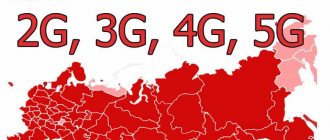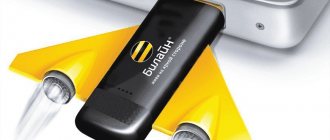Indications of the reception quality of the Tele2 network on the map
4G
High-speed Internet and video in maximum quality are available.
3G
Calls, unlimited internet, music and video are available.
2G
Telephone communication and Internet speed for news and social networks are available.
LTE 450
High-speed Internet available for the most remote areas (Skylink equipment required)
Attention! The computer model of the map is informational; the actual coverage area of the Tele2 network may differ from the simulated data. The differences can be either towards a more confident reception or vice versa.
Factors affecting the quality and reception area of the Tele2 Mobile network:
- Weather conditions: fog, rain, snow.
- The terrain in the reception area is mountains and lowlands.
- The presence of obstacles interfering with the signal propagation, walls, buildings.
- Equipment quality.
Cellular operators 2G, 3G and 4G
MTS operator coverage area
The MTS cellular network coverage map data is updated systematically and frequently, thanks to which our visitors can always see currently relevant information. The MTS color scheme is arranged in this order: pale pink - 3G, pink-orange - 4G.
On the buttons with 3G and 4G network icons, there is a characteristic sign next to the operator’s name. If you click on it, you will see all the available mobile Internet standards to choose from. By pressing the operator icon button again, you can cancel the network being viewed and clear the map screen.
Megafon operator coverage area
To obtain the latest information about the coverage of Megafon networks at the moment, you need to select this operator on the map and select the standard you need (also 3G or 4G).
Tele2 operator coverage area
The Tele2 operator offers fairly decent communication services at low tariffs. Thanks to this, there are users throughout the country in every village and city of Russia. The very developed infrastructure of Tele2 towers allows us to provide the highest speed 3G and 4G Internet.
Beeline operator coverage area
Beeline today is not as active as in those glorious bygone days, but even today in some localities in Russia it has a more developed subscriber base than other operators. Beeline's cellular communication technologies have been modernized, so 4G/LTE Internet has become available.
Beeline coverage gives a general overview; you can roughly analyze the coverage areas of the Beeline network.
Is it possible to increase the reception area of the Tele2 network and improve reception?
Yes! Strengthening the reliable reception area of the Tele2 mobile network is possible. If there is no connection in the place where you stay for a long time (home, office, cottage), and the signal disappears or its quality regularly does not suit you, then installing special repeaters to strengthen the cellular signal can significantly improve the quality of reception.
Repeaters are essentially repeaters of a cellular signal. Your personal communication tower. Repeater models, their number and layout are parameters that require individual study. Much depends on the configuration of the room, wall materials and other factors. You should approach the choice of repeater model carefully; choose a model that can really improve the quality of cellular communications in your premises.
Moscow telecom operator coverage map
The communication coverage area is indicated on the map and is intended to make it more convenient for users to choose operators for their region.
The closer the user lives to the tower and the stronger his cellular signal, the higher the call quality and Internet speed will be. However, the information may not be 100% accurate. The error is formed as a result of uneven terrain, technical parameters of the mobile device, radio conditions in the subscriber's location area and the number of users working in the same cell.
- MTS: 2G
- 3G
- 4G
- Megaphone: 2G
- 3G
- 4G
- 2G
- 2G
- 2G
- 2G
- 4G
- 3G
- 2G
- 2G
- 2G
- 2G
- 2G
- 2G
- 2G
Network faults
How long does it take to fix a communication problem if it occurs?
The Operator provides communication services to Subscribers 24 (twenty-four) hours a day in accordance with the legislation of the Russian Federation, national standards, technical norms and regulations, licenses, as well as an agreement on the provision of communication services.
Unless a different period is established by the legislation of the Russian Federation, the Operator eliminates malfunctions that impede the use of communication services (hereinafter referred to as malfunctions) within 7 (seven) working days from the date of registration of the Subscriber’s request. Malfunctions caused by the actions of third parties must be corrected within 30 (thirty) business days from the moment the Operator became aware of this. In some cases (force majeure circumstances, major accidents, etc.), the timing of troubleshooting is determined by the Operator individually and brought to the attention of Subscribers by posting information on the Operator’s website on the Internet information and telecommunications network.
Largest coverage area
At the end of 2021, experts conducted a study on the scale of operator coverage of the territory of the Russian Federation. First of all, specialists were interested in 4G coverage. The results were surprising.
TELE2, which had been keeping in the shadows for a long time, made a breakthrough and came close to the market giants MegaFon and MTS in creating an LTE zone. Although, if you consider that the operator belongs to Rostelecom and spreads out the network, relying on the latter’s towers, such growth is understandable. Beeline closes the top four.
Map of base stations on Arenda-BS
Here you can see the layout of base stations on an interactive map of communication facilities.
Objects for placing equipment: a pole or tower with communication equipment, a water tower or chimney, antennas on a tower/pole, roof. On the map, objects are highlighted in different colors: green - site, blue - structures and lilac - buildings.
Useful materials from the help section
:
how to determine the direction to the base station yourself
Understanding where the base station of a cellular operator is located is perhaps the main question for anyone who has encountered the problem of a poor mobile signal and has set about fixing it, be it a professional installer of cellular amplification systems or someone who has decided to fix the problem on their own. In this section we will try to help you solve the problem of determining the location of base stations using special maps, compasses, programs and applications. We hope this material will help you achieve your goal.
Should you be afraid of radiation?
Every year, cellular operators launch new stations in Voronezh and the region. They are needed primarily to improve the quality of mobile communications - because speed requirements are constantly increasing. Thanks to base stations, subscribers have uninterrupted cellular communications and Internet access. At the same time, the proximity of cellular stations to residential buildings causes concern among people: they are afraid that electromagnetic radiation will lead to adverse health effects.
Why does radiophobia arise, can radiation from towers affect a person, what standards exist for installing stations on the roofs of residential buildings and who controls compliance with them - in the material of RIA Voronezh.
Tele2 tariffs
At the moment, the tariff plans of the mobile operator Tele2 have become as open as possible. But we decided to highlight and describe the most important advantages for you.
- Now you can easily sell and buy GB of Internet traffic, minutes of calls or SMS messages.
- Gone is the function of turning off when the balance is negative .
- Now you don’t have to worry that an important conversation or the Internet will end at the most inopportune moment.
- Gigabytes of the Internet can be shared with any Tele2 subscriber throughout Russia.
- When calling another Tele2 subscriber, the package is not spent and no money is debited.
- The remaining minutes and GB have become eternal. They simply do not expire at the beginning of a new month, but wait patiently until you spend them.
- Now there is no need to constantly monitor annoying paid subscriptions. It is enough to disable them once and no one will ever turn them on for you without your permission.
These are not all the advantages in the updated policy of Tele2. Not all, but we tried to highlight the most important ones. We hope that this will help you correctly evaluate the advantages and choose the right Tele2 tariff for 4G.
Tele2 Kazakhstan
If you previously had several numbers, then you don’t need to worry about this. is capable of servicing up to 4 subscriber numbers to which you were previously called. Tele2 vs KCell
Revenue
The validity period of the service is 90 days; three days before the end of the service, the subscriber will be sent a warning about the upcoming deactivation of the service.
Tele2 reduced investments in 2014 to 8.3 billion tenge (10.8 billion tenge in 2013). Taking into account the devaluation of the national currency, the difference in investments is even greater.
What are the regulations for installing mobile repeaters on residential rooftops?
The level of permissible electromagnetic radiation is controlled by the regional department of Rospotrebnadzor, focusing on the “Hygienic requirements for the placement and operation of land mobile radio communications” (SanPiN 2.1.8/2.2.4.1190-03) and “Hygienic requirements for the placement and operation of transmitting radio engineering facilities” (SanPiN 2.1.8/2.2.4.1383-03). The placement of cellular infrastructure facilities, including base stations, is planned in such a way as to minimize the impact of electromagnetic fields on people. The antenna radiation pattern in the vertical plane is designed so that the main signal is directed above residential buildings, industrial buildings and structures.
According to regulations, cellular operators are recommended to place antennas on separate supports and masts; the minimum distance from a residential building to the tower should be 7 m. The height of a standard tower is 29 m, its antennas are mounted in the upper part. Mobile repeaters are located at a height of up to 5 m from the roof surface.
High-quality network coverage throughout the city can be ensured by dense buildings and the correct location of communication facilities. The fact is that radio waves do not penetrate every point with the same power. Thick walls of houses can become obstacles. To ensure a reliable network, the operator installs base stations not only on special structures, but also on buildings. Then radio waves can be directed along a specific route and provide a high-quality signal without interruptions in a specific part of the populated area.
If the base station is built on a residential building, the consent of the residents is also required. Otherwise, supervisory authorities impose the same requirements for installing a base station on the roof of a residential building as for the construction of a facility on a mast. This includes obtaining permission to use radio frequencies and registering the base station itself - moreover, the location of the radio electronics and the height of the antenna must comply with the conditions for the use of radio frequencies. At the first stage of construction, the operator submits design documentation to Rospotrebnadzor. Before installing transmitting radio engineering facilities (RTF), sanitary and epidemiological control employees give an appropriate conclusion confirming the safety of the base station. Russia has some of the most stringent standards in the world for the work of PRTOs.
What is radiophobia and why does it occur?
There is no medical diagnosis for radiophobia. Radiophobia refers to neurosomatic mental and physiological disorders, expressed in a person’s unreasonable fear of electromagnetic radiation. The psychotic state is associated with a disordered thinking, impaired perception of reality, lack of awareness of illness, and absurd behavior. A radiophobe physically feels the effects of the waves, and these are symptoms of schizophrenia and a number of other serious diseases.
In the summer of 2021, Russian media immediately reported two cases of damage to cell phone towers by residents. In the Tver region, a man sawed down the support of a tower, the radiation of which, in his opinion, destroyed the harvest of vegetables and fruits on his site. And a resident of the Sverdlovsk region tried to burn down the tower. The arsonist suffered from malaise and insomnia and linked the cause of her poor health to a communications tower located not far from her house.
According to the doctor, if a person is afraid of something, this does not mean that he has a phobia:
– In most cases, we do not experience pronounced fear when coping with potentially dangerous situations that fill the life of a modern person. The less knowledge, the higher the level of anxiety. Most of us instinctively assess the level of real danger for ourselves or our loved ones and choose a way to overcome it.
Alexander Sednev noted that the disease and its causes can only be identified by a psychologist, psychiatrist or psychotherapist.
Available 2G
One of the characteristic features of Tele2 in Russia is the patchwork nature of its distribution. Tele2's coverage area in Russia is located in almost all agglomerations. But the company's development plan is very uneven. In particular, among all federal subjects and administrative units there are always places where TV2 does not receive:
- Of the regions adjacent to Moscow and the Moscow region, the Yaroslavl and Ivanovo regions turn out to be white spots - in these administrative units the signal is almost completely impossible to catch;
- Northern Caucasus east of the Krasnodar Territory. At the same time, the Black Sea and Azov coasts are quite well provided with coverage, but most of the federal subjects of the region do not have Tele2 services;
- Bashkortostan, with the exception of some areas bordering other regions;
- Kalmykia;
- Astrakhan;
- Almost all of Transbaikalia;
- Southern Siberia is also poorly provided with coverage; in Altai there is none at all.
The development plans received from the company declare their determination to completely close these gaps in the coming years. The deployment process is somewhat slowed down due to differences in federal legislation and bureaucratic delays in regional licensing authorities.
Where should the external antenna of a cellular signal booster system point?
When installing a cellular booster system, a directional external antenna provides the greatest effectiveness, and it is very important to choose its direction correctly. It should look at the nearest base station of the cellular operator whose signal needs to be strengthened - MTS, Beeline, Megafon or TELE2.
But what to do if you need to strengthen the signal of more than one operator? Of course, it is not always the case that several operators “fail” at once, but such situations still happen. So what to do in this case?
Fortunately, very often several mobile operators broadcast from one tower at once, and then the task is simplified. We simply point the antenna towards such a “multi-operator” base station. What if there is no such tower and the operators you need are located at different base stations? - There are several options:
- If the separation of the base stations of the cellular operators you need is not too great, simply point the antenna in the middle between them (take into account the viewing angle of the antenna).
- If the desired base stations are located far from each other, at a distance greater than the viewing angle of the directional antenna, then the best option would be to use an omnidirectional antenna with a horizontal viewing angle of 360 degrees.
- An alternative could be to use two cellular signal amplifiers and two directional antennas, so that each set faces the desired cell towers, but, in our opinion, this unreasonably increases the cost of the system and this method should be used only as a last resort, if other options fail positive result.










